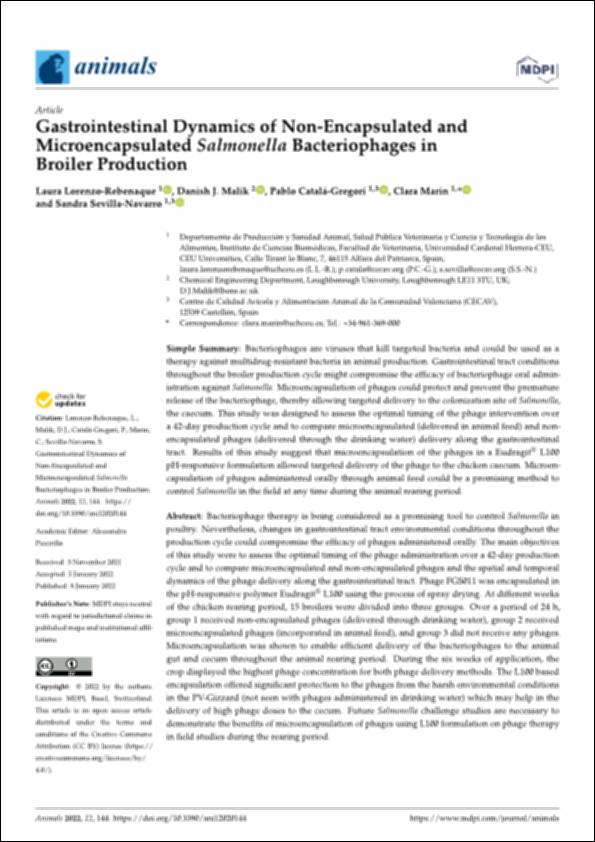Por favor, use este identificador para citar o enlazar este ítem:
http://hdl.handle.net/10637/14245Gastrointestinal dynamics of non-encapsulated and microencapsulated "Salmonella" bacteriophages in broiler production
| Título : | Gastrointestinal dynamics of non-encapsulated and microencapsulated "Salmonella" bacteriophages in broiler production |
| Autor : | Lorenzo Rebenaque, Laura Malik, Danish J. Catalá Gregori, Pablo Marín Orenga, Clara Sevilla Navarro, Sandra |
| Materias: | Pollos - Enfermedades infecciosas - Control.; Chickens - Communicable diseases - Control.; Bacteriophages - Therapeutic use.; Salmonellosis in animals.; Bacteriófagos - Uso terapéutico.; Salmonelosis en los animales. |
| Editorial : | MDPI |
| Citación : | Lorenzo-Rebenaque, L., Malik, D. J., Catalá-Gregori, P., Marin, C. & Sevilla-Navarro, S. (2022). Gastrointestinal dynamics of non-encapsulated and microencapsulated "Salmonella" bacteriophages in broiler production. Animals, vol. 12, i. 2, art. 144 (08 jan.). DOI: https://doi.org/10.3390/ani12020144 |
| Resumen : | Bacteriophage therapy is being considered as a promising tool to control Salmonella in poultry. Nevertheless, changes in gastrointestinal tract environmental conditions throughout the production cycle could compromise the efficacy of phages administered orally. The main objectives of this study were to assess the optimal timing of the phage administration over a 42-day production cycle and to compare microencapsulated and non-encapsulated phages and the spatial and temporal dynamics of the phage delivery along the gastrointestinal tract. Phage FGS011 was encapsulated in the pH-responsive polymer Eudragit® L100 using the process of spray drying. At different weeks of the chicken rearing period, 15 broilers were divided into three groups. Over a period of 24 h, group 1 received non-encapsulated phages (delivered through drinking water), group 2 received microencapsulated phages (incorporated in animal feed), and group 3 did not receive any phages. Microencapsulation was shown to enable efficient delivery of the bacteriophages to the animal gut and cecum throughout the animal rearing period. During the six weeks of application, the crop displayed the highest phage concentration for both phage delivery methods. The L100 based encapsulation offered significant protection to the phages from the harsh environmental conditions in the PV-Gizzard (not seen with phages administered in drinking water) which may help in the delivery of high phage doses to the cecum. Future Salmonella challenge studies are necessary to demonstrate the benefits of microencapsulation of phages using L100 formulation on phage therapy in field studies during the rearing period. |
| Descripción : | Este artículo se encuentra disponible en la siguiente URL: https://www.mdpi.com/2076-2615/12/2/144 Este artículo de investigación pertenece al número especial "Prevention and Control of Poultry Infectious Diseases". |
| URI : | http://hdl.handle.net/10637/14245 |
| Derechos: | http://creativecommons.org/licenses/by/4.0/deed.es |
| ISSN : | 2076-2615 (Electrónico). |
| Idioma: | es |
| Fecha de publicación : | 8-ene-2022 |
| Centro : | Universidad Cardenal Herrera-CEU |
| Aparece en las colecciones: | Dpto. Producción y Sanidad Animal, Salud Pública Veterinaria y Ciencia y Tecnología de los Alimentos |
Los ítems de DSpace están protegidos por copyright, con todos los derechos reservados, a menos que se indique lo contrario.


